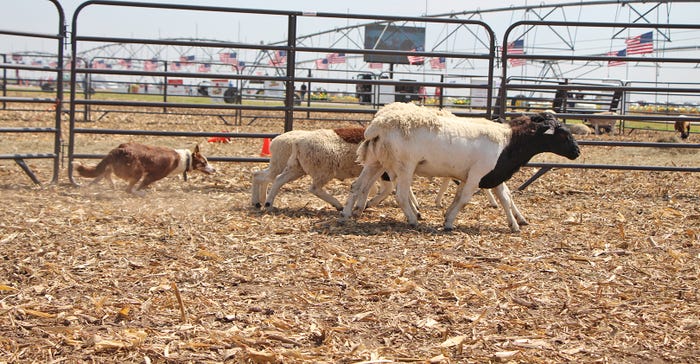
“Lie down. Hey, lie down,” Tim Gifford snapped at his border collie, Kat. “That’ll do. That’ll do.”
Gifford, a Nebraska cattleman, trains herding dogs to work stock. He is a member of the National Cattledog Association and U.S. Border Collie Handler Association. He uses his dogs on his cow-calf operation to gather cows, move them from pasture to pasture, and sort them in an alleyway. Gifford shared his expertise during Husker Harvest Days in Grand Island, Neb.
Here are some of his tips:
1. Start them young. If you’re buying a puppy and you know they are going to work livestock, train them. Teach them basic commands. More importantly, bring young dogs around the stock, Gifford says. It increases awareness and comfort levels with animals.
2. Herd small stock. No matter the size of the dog, if it is possible, begin training with small livestock such as sheep or young calves. This provides safety for the dog, while also adding to its confidence. Plus, as a handler, Gifford explains, it is easier to maneuver the stock and the dog with smaller animals.
3. Get a stick. Handlers need a sorting stick to train. Sorting sticks are tall and bendable. They provide extra reach for the handler. It can be used to move the animals, but more importantly, direct the dog.
4. Know the commands. There are some phrases every dog handler knows:
“Come by " tells the dog to move clockwise.
"Away to me" means move counterclockwise around the stock.
"Lie down” typically means stop and lie down.
“Walk up” means to walk toward the livestock, whether sheep or cattle.
"That'll do" tells the dog work has finished and he must come back to you.
5. Move your body. Combining words with body movement during early training will help the dog understand which way to move. When you say “come by” and make a move to the right, the dog sees and senses the direction.
6. Reward often. Gifford says it is important to reward the dog for the work. In the corral or pasture, it can be just a spoken word or a gentle pat on the head. “It lets the dog know they are doing good work,” he adds. And it builds a strong bond between handler and dog.
Gifford has a gauge to know when a herding dog is fully trained. “Ultimately, I want to get to where I don’t have to be in pen to tell her where to go,” he explains. “I don’t have to sit in corral pens or on the gates. I want her to listen to me and know which way to go.”
About the Author(s)
You May Also Like






